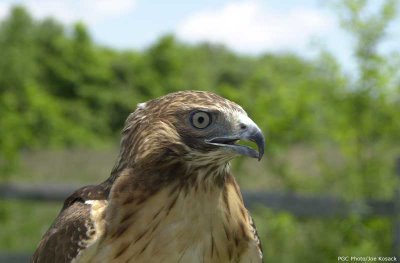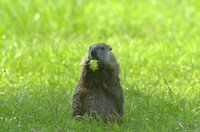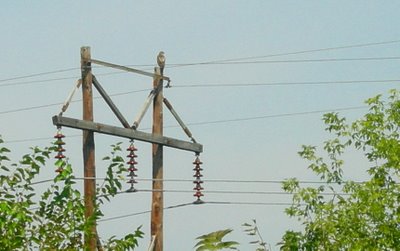
Photo: Steve Wayne Rotsch
Gray foxes are about 3 1/2 feet long and are the only North American canid that climbs trees. They have been sighted in squirrel's nests and abandoned hawk's nests up to 60 feet above the ground.
More from John Blakeman on tough skinned Woodchucks, and other unusual Red-tail menu choices.
Donna,
Ron Austing, with whom I've spent some time with in the field, related to red-tails way back in the 1960s, indeed states that woodchucks are taken by red-tails. I need to clarify this.
There is no doubt that, from time to time, a red-tail will kill a woodchuck. But it's very infrequent, for the reasons I mentioned, particularly the extremely tough hide on a woodchuck.
I have actually tried to feed dispatched woodchucks to my red-tails, and they just have great difficulty tearing into the carcass. Their talons can sometimes pierce the tough skin, but when they grab the skin with their bill and try to tear it open to reveal the flesh, the skin just fails to tear.
I recall trying to feed a fresh woodchuck to a very hungry (but fully healthy) red-tail. The bird tried for five or ten minutes to get into the flesh. Finally, in frustration it jumped off the animal and sat on its nearby perch and expressed a scowling look for the rest of the day. It was not pleased that I presented it with an animal that it couldn't consume, try as it might to get to the flesh.
Later, I removed the woodchuck and sliced open the skin with a sharp knife. The hawk then went to town on the flesh and was delighted. (I had to clean up the resulting mess, as woodchucks have long intestines, and the hawk flicked aside the intestines and their contents in a scattered fecal mess.)
So, I still contend that red-tails are not prominent takers of woodchucks (groundhogs). Farmers here in Ohio hate these big rodents, as a pair with a burrow on the edge of productive soybean field can consume almost every soybean plant in an acre in a week or so in June. But no Ohio farmer ever recalls any local red-tail powering across a flat soybean field to capture a grazing woodchuck. If it happens, it's infrequent and of no consequence.
A few half-grown, newly-emerging woodchucks may be taken by red-tails, but they, too, have tough skin, and after a single, un-rewarded encounter, a red-tail will seldom waste her efforts on another one.
This is not to imply, however, that red-tails can't or won't take larger prey. I have a thoroughly authenticated account of an adult red-tail that descended on a sleeping gray fox and instantly sank its talons through the eye sockets into the cranial cavity, killing the large fox before it could defend itself.
This was in an area with plenty of voles. But this old bird saw the fox curled up in some low grasses and it figured out how to grab and kill it before it awakened. She may have been tired of vole flesh and wanted something new for lunch.
So, no, red-tails don't eat only voles. And they can take an occasional woodchuck. But these are infrequent, inconsequential events.
--John Blakeman
(Pale Male has been known to make unusual choices in food fare as well. One damp chill day while Lola sat the eggs, he appeared above Fifth Avenue carrying a very heavy "something", labored to the nest, and presented her with half of a very large gull, complete with the long white signature wing. D.B.)



